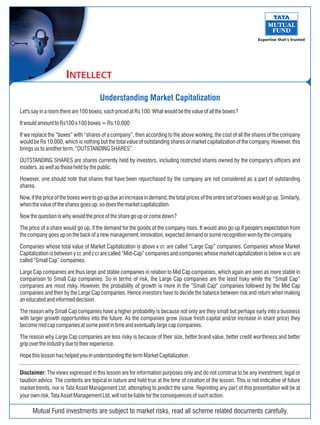
Market Capitalization
- 1. INTELLECT Understanding Market Capitalization Let's say in a room there are 100 boxes, each priced at Rs 100. What would be the value of all the boxes? It would amount to Rs100 x 100 boxes = Rs 10,000 If we replace the “boxes” with “shares of a company”, then according to the above working, the cost of all the shares of the company would be Rs 10,000, which is nothing but the total value of outstanding shares or market capitalization of the company. However, this brings us to another term, “OUTSTANDING SHARES”. OUTSTANDING SHARES are shares currently held by investors, including restricted shares owned by the company's officers and insiders, as well as those held by the public. However, one should note that shares that have been repurchased by the company are not considered as a part of outstanding shares. Now, if the price of the boxes were to go up due an increase in demand, the total prices of the entire set of boxes would go up. Similarly, when the value of the shares goes up, so does the market capitalization. Now the question is why would the price of the share go up or come down? The price of a share would go up, if the demand for the goods of the company rises. It would also go up if people's expectation from the company goes up on the back of a new management, innovation, expected demand or some recognition won by the company. Companies whose total value of Market Capitalization is above x cr. are called “Large Cap” companies. Companies whose Market Capitalization is between y cr. and z cr are called “Mid-Cap” companies and companies whose market capitalization is below w cr. are called “Small Cap” companies. Large Cap companies are thus large and stable companies in relation to Mid Cap companies, which again are seen as more stable in comparison to Small Cap companies. So in terms of risk, the Large Cap companies are the least risky while the “Small Cap” companies are most risky. However, the probability of growth is more in the “Small Cap” companies followed by the Mid Cap companies and then by the Large Cap companies. Hence investors have to decide the balance between risk and return when making an educated and informed decision. The reason why Small Cap companies have a higher probability is because not only are they small but perhaps early into a business with larger growth opportunities into the future. As the companies grow (issue fresh capital and/or increase in share price) they become mid cap companies at some point in time and eventually large cap companies. The reason why Large Cap companies are less risky is because of their size, better brand value, better credit worthiness and better grip over the industry due to their experience. Hope this lesson has helped you in understanding the term Market Capitalization. Disclaimer: The views expressed in this lesson are for information purposes only and do not construe to be any investment, legal or taxation advice. The contents are topical in nature and held true at the time of creation of the lesson. This is not indicative of future market trends, nor is Tata Asset Management Ltd. attempting to predict the same. Reprinting any part of this presentation will be at your own risk. Tata Asset Management Ltd. will not be liable for the consequences of such action. Mutual Fund investments are subject to market risks, read all scheme related documents carefully.
